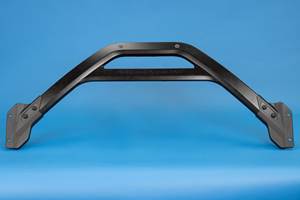London Underground explores composite materials
Mind the gap! The iconic London subway system develops lighter doors made with composites, in partnership with the National Composites Centre, for more efficient transport.
London Underground (LU, London, U.K.) is exploring ways to reduce delays for customers by trialling lighter Tube train doors using award-winning innovative aerospace technology. LU's Innovation Team has led a group of industry experts to explore using composites previously only used in aerospace to construct a commercially viable, lightweight train door.
This award-winning project is in its final stage with the prototype door currently undergoing final rigorous structural testing. This will ensure that the design meets the strictest regulations, ensuring safety for Tube customers.
The group says the benefits of these innovative lighter doors are far-reaching. Customers would benefit from reduced journey times and reduced waiting times on platforms, a saving of 530,000 passenger hours a year. Furthermore, reduction in mechanical stresses in other parts of the door system would reduce the frequency of door-related failures, resulting in fewer delays. The total weight saving of using the lighter composite material for doors across a Central line train would reportedly be 1.25 metric tonnes, with huge benefits on train energy consumption and track wear.
David Waboso, London Underground’s Capital Programmes Director, says “This pioneering project is about our engineers and partners harnessing the latest in technological innovation in order to improve the journeys of our millions of customers. By using this aerospace technology we have the potential to reduce delays and crowding for customers at a time when more and more people are using the Tube. At the same time we can also save millions of pounds to be reinvested in our services and also reduce our impact on the environment.”
Jeff Ive, engineering capability lead at the U.K.'s National Composites Centre and technical lead on the project, says “This project has taken full advantage of the NCC remit to cross-pollinate technologies from different sectors. Using materials often used in an aerospace application and processing them in a novel manner we have been able to deliver an end product that has the potential to improve a public service for generations to come. We have drawn on the experience and insight of engineers, technicians and supply chains across numerous sectors to deliver this challenging project. It is a pleasure to receive acknowledgement from the rail industry, whom we look forward to working with more in future. There is a good opportunity, especially in the field of environmental advance, due to the potential around the recyclability of this product.”
For London Underground the application of these innovative new doors on the Central line alone would mean cost savings of over £5 million a year, energy savings of £100,000 a year; passenger journey time savings worth £4.7m a year; and reduction in track wear, saving £400,000 a year.
In the long term this research will be a push towards future lighter trains, which will reduce operating and maintenance costs. The research also offers the potential to see longer doors installed on existing Tube trains, which would reduce boarding and alighting times. For customers this would mean the possibility of increasing the number of trains running on the Tube.
The project won a Rail Industry Innovation Award in the ‘Environment’ category and has been shortlisted for the prestigious Stephenson Innovation Award with the winner to be announced later this year.
Related Content
Automotive chassis components lighten up with composites
Composite and hybrid components reduce mass, increase functionality on electric and conventional passenger vehicles.
Read MoreASCEND program update: Designing next-gen, high-rate auto and aerospace composites
GKN Aerospace, McLaren Automotive and U.K.-based partners share goals and progress aiming at high-rate, Industry 4.0-enabled, sustainable materials and processes.
Read MoreInfinite Composites: Type V tanks for space, hydrogen, automotive and more
After a decade of proving its linerless, weight-saving composite tanks with NASA and more than 30 aerospace companies, this CryoSphere pioneer is scaling for growth in commercial space and sustainable transportation on Earth.
Read MoreJeep all-composite roof receivers achieve steel performance at low mass
Ultrashort carbon fiber/PPA replaces steel on rooftop brackets to hold Jeep soft tops, hardtops.
Read MoreRead Next
“Structured air” TPS safeguards composite structures
Powered by an 85% air/15% pure polyimide aerogel, Blueshift’s novel material system protects structures during transient thermal events from -200°C to beyond 2400°C for rockets, battery boxes and more.
Read MoreVIDEO: High-volume processing for fiberglass components
Cannon Ergos, a company specializing in high-ton presses and equipment for composites fabrication and plastics processing, displayed automotive and industrial components at CAMX 2024.
Read MorePlant tour: Daher Shap’in TechCenter and composites production plant, Saint-Aignan-de-Grandlieu, France
Co-located R&D and production advance OOA thermosets, thermoplastics, welding, recycling and digital technologies for faster processing and certification of lighter, more sustainable composites.
Read More














.jpg;maxWidth=300;quality=90)









